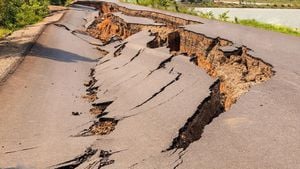California has found itself gripped by an unusually intense heat wave this October, one that's breaking records and bringing about sweltering conditions from the north to the south of the state. It seems like the traditional cooler autumn months have been eclipsed by blistering temperatures, prompting numerous heat alerts and safety warnings across various regions.
According to the National Weather Service (NWS), portions of the Golden State are forecasted to experience temperatures reaching as high as 110°F (43°C). The Weather Prediction Center noted, "Record-breaking heat will continue across portions of the Southwest this week," indicating significant heat impacts, particularly near cities like San Francisco, Los Angeles, and Las Vegas. On Wednesday, many locations across California, spanning from the Bay Area down to Tijuana, Mexico, were placed under Excessive Heat Warnings.
Earlier this week, Sacramento etched its name in the history books when temperatures soared to 103°F, marking it as the hottest October day on record. Just the day before, the city had tied its previous record of 102°F. Nearby Stockton also braved record-breaking heat, hitting highs of 105°F. These readings were alarming, pushing the city to extend heat advisories through the week and offering resources to citizens, especially those most vulnerable to heat, such as the elderly.
For many Californians, this has meant seeking refuge at cooling centers, which scattered across the region. According to officials, many of these centers extended their operating hours to accommodate residents unable to cope with the oppressive heat. City transit systems, like SacRT, provided free rides to these cooling locations, ensuring regular access to relief from the soaring temperatures. Meanwhile, locals are being urged to check on their neighbors and friends, particularly those who are isolated.
But why is October seeing such extreme heat? Scientists are quick to point out the role of climate change, which is transforming seasonal weather patterns. Kristina Dahl, a climate scientist with the Union of Concerned Scientists, explained, "Climate change is causing the length of the heat season to increase and is making late-season heat waves like this more frequent." The trend of excessive heat isn't confined to California alone; it's echoing across the Western U.S., with places like Phoenix and Las Vegas also recording unprecedented temperatures.
Phoenix, Arizona, stands at the heart of this scalding wave, recording its second-severest October day with 113°F. This has taken its tally of days exceeding 105°F this year to 113, cementing its reputation for having relentless heat. Meanwhile, neighboring Death Valley is expected to see lows around 113°F this weekend, marking perilous conditions for anyone outdoors.
This record heat wave is far from isolated; the effects are holistic. More than 50 heat records were notched just this week across the Western U.S., prompting exposure advisories meant to keep residents safe. The forecast shows no signs of letting up soon, with extreme heat warnings extending to Arizona, Nevada, and parts of California's Bay Area.
Local officials have been proactive, urging residents to remain indoors where possible, stay hydrated, and look out for possible heat-related illnesses. The warnings also highlight the danger of not cooling down enough overnight, which can make the risk of heat illnesses even more pronounced. Tragically, excessive heat has already linked to over 300 deaths this year alone throughout Maricopa County, which encompasses Phoenix.
Reports are showing how disparities emerge during extreme weather events. Communities with fewer resources find it substantially harder to cope with such extreme weather; they often lack access to reliable cooling systems or nearby cooling stations. The current October heat wave has raised discussions about social inequalities and the urgent need for more accessible and equitable climate plans.
Interestingly, this heat wave is challenging historical patterns, as October traditionally marks the transition to cooler weather. Yet, with many places already hitting 100°F, residents are forced to rethink what fall means in the era of climate change. The phenomenon of extended heat seasons is growing more prevalent, and earlier summers are becoming increasingly typical as global temperatures climb due to fossil fuel emissions.
Looking forward, meteorologists predict the worst of this heat may ease as we move toward mid-October, with potential cooler weather on the horizon. But for now, Californians are bracing themselves for more record-breaking days. The need for adaptation and preparation has never been clearer, as communities strive to navigate the uncharted waters of climate impacts.
The current heat crisis serves as both a warning and reminder of the changes already taking place and the need for consciousness about our collective environmental footprint. It encapsulates the urgent fight against climate change—a challenge more real than ever before.
With the days still tipping back toward record highs and nights getting warmer, Californians will continue to share stories of resilience, solidarity, and collaborative efforts to battle this unusual weather for the foreseeable future.



